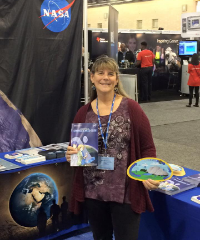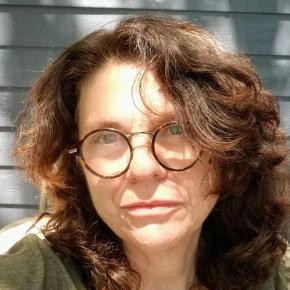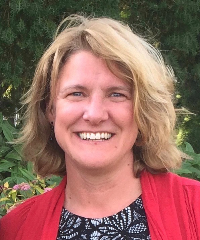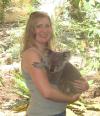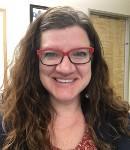Community Blogs
Community Blogs
Discover how the GLOBE community is engaging in all things GLOBE through the community blog posts below.
Learn how to create a GLOBE community blog post.
Filter By:
Blogs List
Many of us are so used to having clean freshwater that is easily accessible that we don't often stop to marvel at the fact that we are incredibly fortunate. The majority of our freshwater comes from our water cycle, and precipitation is unevenly distributed across the globe. You can learn more about the importance of clean freshwater resources in this "one-pager" entitled " Precious Freshness ".
During our ENSO Phase III Webinar #3, we will be focusing on water quality in Europe and Eurasia. We will host this webinar at 18:30 UCT, and hope we will have many of you from ...
Read More »
Posted in:
Curriculum:
SCIENCE AND MATH
LANGUAGE CULTURE AND ARTS
STEM
Event Topics:
CAMPAIGNS AND PROJECTS (IOPS, ETC)
SCIENCE SYMPOSIA AND FAIRS
Field Campaigns:
WATERSHEDS
EL NIÑO
GLOBE Science Topics:
GENERAL SCIENCE
EARTH AS A SYSTEM
SCIENTIST SKILLS
GLOBE PROTOCOLS
GLOBE Working Groups:
EDUCATION WORKING GROUP
SCIENCE WORKING GROUP
Investigation Areas:
HYDROSPHERE
Learning Activities:
ATMOSPHERE AND CLIMATE
HYDROLOGY
News Topics:
VIRTUAL SCIENCE FAIR
SCRC RESEARCH
Primary Audience:
PARTNERS
SCIENTISTS
ALUMNI
COUNTRY COORDINATORS
TRAINERS
TEACHERS
STUDENTS
It is pretty neat when you can get two for the price of one- as most teachers can attest to with regard to trying to get everything into their curriculum. Did you know that this year, the FIRST LEGO League's challenge is focused on water. And what could be better, as that water is also the theme of this year's ENSO Student Research Campaign !
The LEGO Challenge Project states: "People use water every day, but they don’t think much about how and why they use water. Whether it’s directly (drinking or washing) or indirectly (manufacturing the products they use or producing food ...
Posted in:
Curriculum:
STEM
SCIENCE AND MATH
Event Topics:
CAMPAIGNS AND PROJECTS (IOPS, ETC)
SCIENCE SYMPOSIA AND FAIRS
COMPETITIONS
Field Campaigns:
EL NIÑO
WATERSHEDS
GPM
GLOBE Science Topics:
EARTH AS A SYSTEM
EARTH SYSTEM SCIENCE
GLOBE PROTOCOLS
CLIMATE CHANGE
CLIMATE
Investigation Areas:
ATMOSPHERE
Learning Activities:
EARTH AS A SYSTEM
ATMOSPHERE AND CLIMATE
News Topics:
COMPETITIONS
Primary Audience:
TEACHERS
STUDENTS
Observations of daily precipitation have been a part of GLOBE from the beginning. At the start, GLOBE’s participation model was that schools would take measurement following all of the original 17 protocols. Atmosphere temperature, precipitation, cloud, and soil moisture measurements were to be collected daily at a site easily accessible to the school. A permanent installation of an instrument shelter containing a max/min thermometer mounted to a post along with a rain gauge was the expected norm with other measurements taken nearby. Daily temperature and precipitation measurements were ...
Posted in:
Field Campaigns:
EL NIÑO
GPM
GLOBE Science Topics:
GLOBE PROTOCOLS
GLOBE Working Groups:
SCIENCE WORKING GROUP
EDUCATION WORKING GROUP
Investigation Areas:
ATMOSPHERE
Primary Audience:
TRAINERS
TEACHERS
STUDENTS
PARTNERS
COUNTRY COORDINATORS
Teacher's Guide:
DOCUMENT TYPES
From the start, the measurement of daily maximum and minimum air temperature within one hour of local solar noon has been a key GLOBE protocol. The low cost approach was to use a U-tube thermometer housed in a wooden instrument shelter facing away from the equator. The U-shaped tube contained mercury with pins on either side of the mercury. As the air temperature warmed the pin on one side would move while the other pin stayed in place; when the air cooled, the pin on the other side would be pushed up. The pins were held in place by magnetized strips behind the thermometer tube so that ...
Posted in:
Curriculum:
STEM
TECHNOLOGY
GLOBE Science Topics:
EARTH AS A SYSTEM
EARTH SYSTEM SCIENCE
GLOBE PROTOCOLS
CLIMATE CHANGE
CLIMATE
GLOBE Working Groups:
SCIENCE WORKING GROUP
Investigation Areas:
ATMOSPHERE
Primary Audience:
TEACHERS
TRAINERS
STUDENTS
PARTNERS
SCIENTISTS
ALUMNI
COUNTRY COORDINATORS
One of the things I do as a GLOBE partner is facilitate workshops for educators. When I facilitate a workshop for credit, I always require a short reflection. I use reflection because when teachers, like all of us, stop and think about what they learned the learning is deeper and more relevant. And, candidly, they are more likely to implement GLOBE into their classrooms.
To give participants direction in their reflecting, I use the 4 R model of reflection: review, relate, remark, revise.
- Review. Participants review and summarize one salient aspect of the workshop . ...
Posted in:
Curriculum:
ASSESSMENT AND EVALUATION
LANGUAGE CULTURE AND ARTS
SCIENCE AND MATH
Event Topics:
WORKSHOPS
GLOBE Science Topics:
GLOBE PROTOCOLS
Investigation Areas:
CLOUDS
Learning Activities:
CLOUD WATCH
OBSERVING, DESCRIBING, AND IDENTIFYING CLOUDS
ESTIMATING CLOUD COVER
Primary Audience:
TRAINERS
TEACHERS
PARTNERS
COUNTRY COORDINATORS
Teacher's Guide:
UPPER PRIMARY: 3-5
I was selected as a National Geographic 2017 Grosvenor Teacher Fellow which is a professional development opportunity that provides educators a rich, immersive experience exploring the world to bring back to their teaching and communities. I and two other educators traveled with Lindblad Expeditions around Svalbard, Greenland and Iceland on the ship the National Geographic Explorer, making stops for excursions along the way.
I decided to do field work on my Grosvenor Teacher Fellowship because 1) that is what one does on an expedition according ...
Posted in:
Curriculum:
SCIENCE AND MATH
GLOBE Science Topics:
EARTH SYSTEM SCIENCE
GLOBE PROTOCOLS
Learning Activities:
ATMOSPHERE AND CLIMATE
Primary Audience:
TRAINERS
TEACHERS
STUDENTS
PARTNERS
SCIENTISTS
ALUMNI
COUNTRY COORDINATORS
Just when you think that perhaps the weather systems are settling down- our amazing scientific instruments are able to detect a potential change! I never cease to be amazed at what we are able to learn about Earth's systems- both from the ground and from space!
This article from the New York Times just came across my newsfeed- " It's Like it Never Left: Another El Nino May be on the Way ".
In the article, it states that " Among the potential effects are wetter conditions across the southern United States, including Southern California; a drier Midwest; and drought in ...
Posted in:
Curriculum:
STEM
EDUCATION RESEARCH
SCIENCE AND MATH
Event Topics:
CAMPAIGNS AND PROJECTS (IOPS, ETC)
Field Campaigns:
EL NIÑO
GLOBE Science Topics:
EARTH SYSTEM SCIENCE
CLIMATE CHANGE
BACKYARD SCIENCE
CLIMATE
EARTH AS A SYSTEM
SCIENTIST SKILLS
GLOBE PROTOCOLS
GLOBE Working Groups:
EDUCATION WORKING GROUP
Investigation Areas:
ATMOSPHERE
EARTH AS A SYSTEM
HYDROSPHERE
PEDOSPHERE (SOIL)
BIOSPHERE
News Topics:
VIRTUAL SCIENCE FAIR
Primary Audience:
PARTNERS
SCIENTISTS
ALUMNI
COUNTRY COORDINATORS
TRAINERS
TEACHERS
STUDENTS
Consider the rain gauge used in GLOBE, CoCoRaHS, and other citizen science programs. Just four pieces plus 2 mounting screws – an inner graduated cylinder, an outer cylinder, a cap/funnel, and a mounting bracket. The area of the outer tube is exactly 10 times the areas of the inner tube and the cap/funnel, so the graduations on the inner cylinder can be spaced ten times further apart. Thus, 0.2 mm of rain fills the inner tube to a depth of 2.0 mm, which one can read.
In addition, if heavy rainfall fills the inner cylinder, the rest of the rainfall overflows into the outer cylinder, ...
Posted in:
Curriculum:
STEM
Field Campaigns:
EL NIÑO
GPM
GLOBE Science Topics:
BACKYARD SCIENCE
GLOBE PROTOCOLS
Investigation Areas:
ATMOSPHERE
Primary Audience:
TEACHERS
STUDENTS
ALUMNI
Please welcome Guest Blogger Shona Emery , a GLOBE 5th/6th Grade STEAM Teacher from Ellis School in Fremont, New Hampshire.
This blog is the fourth in a series of posts by GLOBE teachers sharing classroom experiences to support the student research process. The series is supported by NSF funding for the United States Regional Student Research Symposia . If you are a teacher interested in contributing, please contact Haley Wicklein for more information. Specifically, we would love to hear from teachers who can share challenges and advice around the topic of student data ...
Posted in:
Curriculum:
SCIENCE AND MATH
Event Topics:
SCIENCE SYMPOSIA AND FAIRS
GLOBE Science Topics:
SCIENTIST SKILLS
GLOBE PROTOCOLS
GENERAL SCIENCE
Investigation Areas:
DISSOLVED OXYGEN
FRESHWATER MACROINVERTEBRATES
HYDROSPHERE
WATER TEMPERATURE
WATER TRANSPARENCY
PH
Learning Activities:
PRACTICING YOUR PROTOCOLS
Primary Audience:
TEACHERS
Teacher's Guide:
DATA SHEETS
UPPER PRIMARY: 3-5
MIDDLE: 6-8
SITE DEFINITION SHEETS
PROTOCOL INSTRUCTIONS
FIELD GUIDES
Concerns regarding the impact of global warming on vector-borne diseases have intensified interest in the relationship between atmospheric factors and dengue fever incidence. Global climate change poses the threat of serious social upheaval, population displacement, economic hardships, and environmental degradation. Changes in temperature, rainfall and relative humidity have potential to enhance vector development, reproductive and biting rates, shorten pathogen incubation period and encourage adult longevity. In addition, changes in wind direction, velocity and frequency will have an ...
Posted in:
GLOBE Science Topics:
CLIMATE CHANGE
GLOBE PROTOCOLS
Investigation Areas:
HYDROSPHERE
Learning Activities:
HYDROLOGY
Primary Audience:
TEACHERS
STUDENTS
Please welcome Guest Blogger Jayme Margolin-Sneider , a GLOBE 6-8 grade science teacher and STEM Advisor from Westview Middle School in Longmont, Colorado.
This is the second in a series of posts by GLOBE teachers sharing classroom experiences to support the student research process. The series is supported by NSF funding for the United States Regional Student Research Symposia . If you are a teacher interested in contributing, please contact Haley Wicklein for more information.
Thank you to Jayme for sharing this!
Last year, I had two different groups of ...
Posted in:
Curriculum:
SCIENCE AND MATH
Event Topics:
MEETINGS
COMPETITIONS
SCIENCE SYMPOSIA AND FAIRS
GLOBE Science Topics:
SCIENTIST SKILLS
GLOBE PROTOCOLS
GENERAL SCIENCE
DATA INCLUDED
MEETINGS/CONFERENCES
News Topics:
COMPETITIONS
MEETINGS
REGIONS
Primary Audience:
TEACHERS
STUDENTS
PARTNERS
In most scientific research an important test is whether the results of an experiment can be repeated, typically repeated by another lab and research group. A result that cannot be confirmed in this way is generally viewed as invalid. This is a great test for controlled experiments where virtually identical experimental conditions may be achieved.
In Earth science research involving observations of the natural world, experimental conditions cannot be reproduced. For environmental research the standard must switch for repeatable to intercomparable – capable of being compared. ...
Posted in:
GLOBE Science Topics:
GENERAL SCIENCE
EARTH SYSTEM SCIENCE
BACKYARD SCIENCE
GLOBE PROTOCOLS
Investigation Areas:
HYDROSPHERE
PEDOSPHERE (SOIL)
ATMOSPHERE
BIOSPHERE
Primary Audience:
TRAINERS
TEACHERS
STUDENTS
SCIENTISTS
ALUMNI
Guest Blog by NASA SMAP Scientists Dr. Erika Podest and Dr. Narendra Das of the NASA Jet Propulsion Laboratory in Pasadena, California USA.
SMAP scientists are using soil moisture in a number of ways, ways that allow all of us to better understand water’s role on Earth:
Weather Prediction : Water in the soil has the potential to evaporate (depending on atmospheric temperature and pressure) and when it does it plays a large role in cloud formation. Soil moisture also has a modulating effect on air temperature and humidity therefore having the ability to measure soil moisture ...
Posted in:
Field Campaigns:
SMAP
GLOBE Science Topics:
EARTH AS A SYSTEM
SCIENTIST SKILLS
EARTH SYSTEM SCIENCE
GENERAL SCIENCE
GLOBE PROTOCOLS
Investigation Areas:
PEDOSPHERE (SOIL)
Primary Audience:
TRAINERS
TEACHERS
STUDENTS
PARTNERS
SCIENTISTS
ALUMNI
COUNTRY COORDINATORS
The SMAP Mission is vital to understanding our planet. Water is an essential source for life. By understanding the amount of water in the soil, or soil moisture, we can apply this information to many things.
Monitoring Drought
SMAP monitors soil moisture and provides critical information for drought early warning. In fact, a deficit in the amount of moisture in the soil defines agricultural drought. SMAP's measurements will come into play because researchers forecast a threefold increase in drought frequency in many regions of the world by the end of the 21st Century. ...
Posted in:
Field Campaigns:
SMAP
GLOBE Science Topics:
GLOBE PROTOCOLS
Investigation Areas:
PEDOSPHERE (SOIL)
Primary Audience:
TRAINERS
TEACHERS
STUDENTS
PARTNERS
COUNTRY COORDINATORS
Weekly Report 1: 10/1/15 - 10/15/15
This report contains two weeks of data collection due to the beginning of the campaign on October 1, 2015:
Volumetric Soil Moisture Measurements = 19
Participating Sites = 4
Schools Submitting Data:
Shumate Middle School - Michigan - 8 data counts
Ramey School - Puerto Rico -7 data counts
The University of Toledo -Ohio - 2 data counts
Thomas Edison Energy/Smart Charter School - New Jersey - 2 data counts
Congratulations to those schools for getting a great start. Let's get more schools participating!
Brian
Posted in:
Curriculum:
SCIENCE AND MATH
Field Campaigns:
SMAP
GLOBE Science Topics:
GLOBE PROTOCOLS
Investigation Areas:
PEDOSPHERE (SOIL)
News Topics:
COMPETITIONS
Primary Audience:
TRAINERS
TEACHERS
STUDENTS
PARTNERS
COUNTRY COORDINATORS
Blog originally posted on the GLOBE Scientists' Blog: http://blog.globe.gov/sciblog/2012/10/24/as-the-last-leaf-falls/
This was my first year doing the Green-Down Protocol with GLOBE. I am trained as an atmospheric scientist, so I have taken many atmospheric measurements over the course of my career. I had not ventured into the world of phenology until I joined GLOBE. More so, I am intrigued by this field of Earth Science, since it is closely connected to climate and can be a very good indicator of a climate change.
This year, as part of the GLOBE Phenology and ...
Posted in:
GLOBE Science Topics:
GLOBE PROTOCOLS
Communities in the Sahel region of Africa depend on trees for firewood, food, building materials, and even medicine. Anecdotal observations in this savannah climate, a transition region to the south of the Sahara Desert, have suggested the number of trees is decreasing. A recent study by a group of researchers at the University of California at Berkeley has provided scientific support indicating that trees are indeed dying and the decline is being attributed to climate change. Scientists looked at aerial photos dating back to 1954, satellite images, climate change ...
From January 22 to 26, 2012, scientists from around the world gathered for the American Meteorological Society annual meeting, which was held in New Orleans, Louisiana. Scientists from the GLOBE Program stayed next to the beautiful Mississippi River.
The Mississippi River in New Orleans (photo courtesy of Dr. Donna Charlevoix)
The Mississippi River is the lifeblood of New Orleans and has so impacted the city that the city was actually developed around it. The first buildings were constructed around the river edge, which has the highest ground, and now ...
Posted in:
GLOBE Science Topics:
EARTH SYSTEM SCIENCE
GLOBE PROTOCOLS
Investigation Areas:
HYDROSPHERE
Primary Audience:
STUDENTS
—
20 Items per Page






